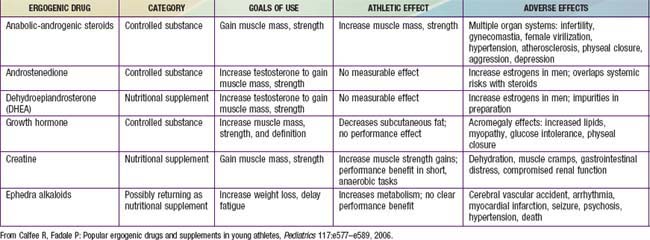Chapter 683 Performance-Enhancing Aids
Performance-enhancing drugs have been used by athletes since at least since 776 BCE. Ergogenic aids are substances used for performance enhancement, most of which are unregulated supplements (Table 683-1). The 1994 Dietary Supplement and Health Education Act limited the ability of the U.S. Food and Drug Administration to regulate any product labeled as a supplement. Many agents have significant side effects without proven ergogenic properties. In 2005, the American Academy of Pediatrics published a policy statement strongly condemning their use in children and adolescents. The US 2004 Controlled Substance Act outlawed the purchase of steroidal supplements such as tetrahydrogestrione (THG), and androstenedione (Andro), with the exception of dehydroepiandrosterone (DHEA).
American Academy of Pediatrics. American Academy of Pediatrics policy statement: use of performance enhancing substances. Pediatrics. 2005;115:1103-1106.
Calfee R, Fadale P. Popular ergogenic drugs and supplements in young athletes. Pediatrics. 2006;117:e577-e589.
The Medical Letter. Performance-enhancing drugs. Med Lett. 2004;46:57-60.
Meinhardt U, Nelson AE, Hansen JL, et al. The effects of growth hormone on body composition and physical performance in recreational athletes. Ann Intern Med. 2010;152:568-577.
Miah A. Doping and the child: an ethical policy for the vulnerable. Lancet. 2005;366:874-876.
Seifert SM, Schaechter JL, Hershorin ER, et al. Health effects of energy drinks on children, adolescents, and young adults. Pediatrics. 2011;127(3):511-528.
Sjoqvist F, Garle M, Rane A. Use of doping agents, particularly anabolic steroids in sports and society. Lancet. 2008;371:1872-1882.
Tokish JM, Kocher MS, Hawkins RJ. Ergogenic aids: a review of basic science, performance, side effects, and status in sports. Am J Sports Med. 2004;32:1543-1553.







